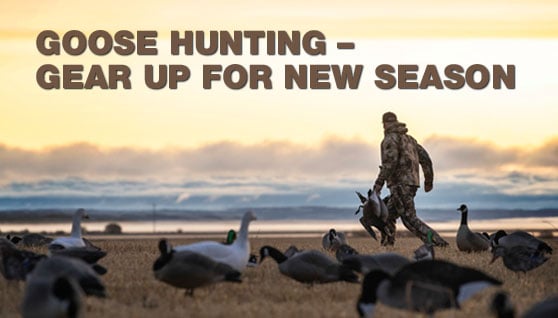Last Updated on
A lot of hunters are looking forward to goose hunting season and consider it as one of the most exciting activities in their lives. But we assure you that cooking harvested geese and ducks is as much enjoyable as hunting them.
Unlike most wild ducks, goose meat undeservedly has gotten a bad name as greasy, livery, and tough. Yes, it can taste like these things but prepared properly, it’s amazingly delicious.

Cooking a wild goose or duck a little differs from a farm-raised or domestic one. Wild birds fly great distances, and there is much less fat on them. So, it’s very easy to dry out the meat through improper preparation or overcooking. For this reason, you may need to add extra fat while cooking to ensure a moist and tender bird. Here are some basic tips on how to cook your wild game incredibly delicious.
Cooking a Whole Bird
To cook a whole duck or goose may be pretty challenging. Sometimes it seems hardly possible to get the combination of crispy skin, tender meat just roasting your game bird in an oven. You have either crispy skin and overcooked breast or well-cooked meat and skin that is far not crispy. But you are more likely to succeed if dealing with wild birds as they are usually not so fat.

The vital thing when roasting a wild duck or a goose is a really hot oven. The temperature should not be lower than 400°F or even higher. And remember, the smaller the bird, the hotter the oven. In some cases, the perfect temperature may be up to 500°F. Don’t forget to preheat the oven for 20 to 30 minutes.
But if you have a really fat wild duck or goose, it’s better to roast the bird at a lower temperature of nearly 325°F. To help crisp the skin, pierce it with a needle all over the bird before setting it into the oven – it lets the fat render out – and increase the heat to 450°F for the last 30 minutes. We don’t recommend covering your wild bird while roasting if you want that crispy skin. When covered, the bird will steam.
How to know a roast duck or goose is ready? The legs feel loose, the fat runs clear, and the skin is crunchy.
Duck with Grapes

This is a very simple recipe by Hank Shaw that is done with fat wild ducks. It’s not recommended to do this with a skinny wild duck, as the meat will dry out too much. And yes, a duck must be plucked. You can replace pearl onions with shallots if you want. Always eat this with good bread.

Cooking the Bird by Parts
Not always geese and ducks are worth whole roasting. In some cases, it’s better to divide the bird up into various parts for separate cooking. Wild game birds often have broken legs, shot-up breasts, or they may be skinny and old. Even more, breasts, legs, and wings require different temperature degrees and time while cooking to become tender. And that’s quite difficult with a whole bird. So, if you don’t feel like cooking a whole duck or goose, break it down. There are thousands of different ways and recipes of cooking goose and duck parts to any liking.
Breasts should be cooked rare-to-medium, no matter if you sear, roast, or grill them. If breasts are overcooked they will be livery. You can also make jerky, pastrami, cutlets, tacos, as well as smokes breasts. Legs, thighs, and wings need a slow cook to become tender. They are good for stewing, frying, roasting, braising, or making confits. Carcasses go into stock or broth. You can also cook tongues, hearts, gizzards, giblets in lots of ways. The greatest thing is that you can use almost every part of the bird.
Shredded Goose With Lemon

This is a recipe by Hank Shaw that works great with skinned goose legs, and duck legs as well. You slow cook the goose legs with duck fat, or olive oil, garlic, lemon juice, and sherry. Serve a ready dish with crusty bread or rice.

Breaking the Bird Down
If you are going to cook separate parts of the bird, you need a good-quality sharp boning knife to break the bird down. VICTORINOX Flexible Boning Knife is a good one. Featuring a 6″ straight, narrow, flexible blade, this knife is highly recommended by leading gourmet ratings and reviews publication year after year.
You can choose a chef knife as well though it may be too wide to do a lot of fine work. However, the choice depends on your preferences. The main thing is that the knife is razor-sharp and comfortable to handle.
Here is a selection of more VICTORINOX knives that help turn the game bird into parts easily.
Conclusion
The most important thing while cooking wild duck and goose is not to overcook it. A finished piece of meat should be tender and pink all the way through. But don’t be afraid to try even if you didn’t succeed for the first time. The best way to master your cooking skills is to practice again and again. When done properly, you’ll discover that goose or duck meat is one of the best wild ones you have ever eaten.
Check out other articles on cooking:











